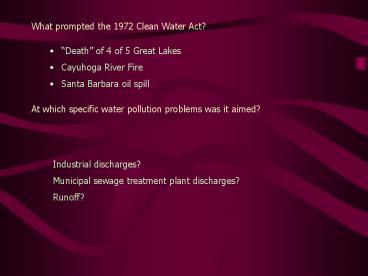What prompted the 1972 Clean Water Act? PowerPoint PPT Presentation
1 / 21
Title: What prompted the 1972 Clean Water Act?
1
What prompted the 1972 Clean Water Act? At
which specific water pollution problems was it
aimed?
- Death of 4 of 5 Great Lakes
- Cayuhoga River Fire
- Santa Barbara oil spill
Industrial discharges? Municipal sewage treatment
plant discharges? Runoff?
2
WATER POLLUTION PROBLEMS/SOURCES POLLUTANTS SOU
RCES Conventional Industrial discharges Non-conv
entional Municipal sewage Toxic treatment
(POTW) discharges Runoff
3
CWA SECTION 301(a) Except as in compliance
various permitting provisions of the Act
including Sections 402 and 404 of the Act of
this title, the discharge of any pollutant by any
person shall be unlawful. Section 402
discharge permits Section 404 wetland
permits Who issues these permits?
4
CWA SECTION 402(a) NPDES Permits (1) the
Administrator may, after opportunity for public
hearing issue a permit for the discharge of any
pollutant, or combination of pollutants upon
condition that such discharge will meet the
requirements of the Act. (2) The Administrator
shall prescribe conditions for such permits ,
including conditions on data and information
collection, reporting, and such other
requirements as he deems appropriate.
5
CWA requires permitted industrial dischargers to
comply with the following technology-based
effluent standards, created by EPA, for
individual industrial categories. These
standards reflect
CONVEN. NON-CONV. TOXIC SOURCE POLL. POLL. POL
L. EXISTING BCT/BPT BAT BAT NEW BAT BAT BAT
POTWs?
6
- CWA Section 302 Permitting agency may impose
water-quality based limitations in permit
whenever, in the judgment of the Administrator
discharges of pollutants from a point source or
group of point sources, with the application of
technology-based effluent limitations would
interfere with the attainment or maintenance of
that water quality in a specific portion of the
navigable waters which shall assure protection of
public health - CWA Section 304 Specifies planning procedures
to ensure that water quality based permit limits
will be imposed on dischargers into impaired
waters. - TMDL program
7
Municipal Sewage Treatment Plant (POTW) Standards
Primary treatment settling/filtering Secondary
treatment biological Tertiary treatment
chemical
8
(No Transcript)
9
Red industrial discharger Blue toxic
release (air/water/land)
10
NRDC v. Costle (D.C. Cir. 1977) To what EPA
action is NRDC objecting here? Why did EPA
interpret its regulatory jurisdiction
restrictively? Why wouldnt they try to maximize
their reach?
11
DISCHARGE PROHIBITION
CWA SECTION 301(a) Except as in compliance
various permitting provisions of the Act
including Section 402s and 404 of the Act of
this title, the discharge of any pollutant by any
person shall be unlawful.
12
Discharge Definition
CWA Section 502 (12) The term ''discharge of a
pollutant'' and the term ''discharge of
pollutants'' each means (A) any addition of any
pollutant to navigable waters from any point
source, (B) any addition of any pollutant to the
waters of the contiguous zone or the ocean from
any point source other than a vessel or other
floating craft.
13
Point source Definition
CWA Section 502
(14) The term ''point source'' means any
discernible, confined and discrete conveyance,
including but not limited to any pipe, ditch,
channel, tunnel, conduit, well, discrete fissure,
container, rolling stock, concentrated animal
feeding operation, or vessel or other floating
craft, from which pollutants are or may be
discharged. This term does not include
agricultural stormwater discharges and return
flows from irrigated agriculture.
14
NRDC v. Costle (D.C. Cir. 1977) To what EPA
action is NRDC objecting here? Why did EPA
interpret its regulatory jurisdiction
restrictively? Why wouldnt they try to maximize
their reach? Why did NRDC challenge EPAs
action? What did the court think of EPAs
rationale? What is the difference between an
exemption and a general permit?
15
NRDC v. Costle (D.C. Cir. 1977) To what EPA
action is NRDC objecting here? Why did EPA
interpret its regulatory jurisdiction
restrictively? Why wouldnt they try to maximize
their reach? Why did NRDC challenge EPAs
action? What did the court think of EPAs
rationale? What is the difference between an
exemption and a general permit? Note that
exemptions benefited agriculture, mostly. What
if rain causes channeled runoff from a farm pond
to escape into creek? Hydroelectric facility
example.
16
Pollutant Definition
CWA Section 502
(6) The term ''pollutant'' means dredged spoil,
solid waste, incinerator residue, sewage,
garbage, sewage sludge, munitions, chemical
wastes, biological materials, radioactive
materials, heat, wrecked or discarded equipment,
rock, sand, cellar dirt and industrial,
municipal, and agricultural waste discharged into
water...
17
U.S. v. Plaza Health Labs (2d Cir. 1993) How did
this defendant violate the CWA, according to the
prosecutor? What defenses did the defendant raise
to liability?
18
DISCHARGE PROHIBITION
CWA SECTION 301(a) Except as in compliance
various permitting provisions of the Act
including Section 402s and 404 of the Act of
this title, the discharge of any pollutant by any
person shall be unlawful.
19
Discharge Definition
CWA Section 502 (12) The term ''discharge of a
pollutant'' and the term ''discharge of
pollutants'' each means (A) any addition of any
pollutant to navigable waters from any point
source, (B) any addition of any pollutant to the
waters of the contiguous zone or the ocean from
any point source other than a vessel or other
floating craft.
20
Point source Definition
CWA Section 502
(14) The term ''point source'' means any
discernible, confined and discrete conveyance,
including but not limited to any pipe, ditch,
channel, tunnel, conduit, well, discrete fissure,
container, rolling stock, concentrated animal
feeding operation, or vessel or other floating
craft, from which pollutants are or may be
discharged. This term does not include
agricultural stormwater discharges and return
flows from irrigated agriculture.
21
U.S. v. Plaza Health Labs (2d Cir. 1993) How did
this defendant violate the CWA, according to the
prosecutor? What defenses did the defendant raise
to liability? With whom did the court side?
Why? What was the dissents position. Do you
agree with the majority or the dissent here?

